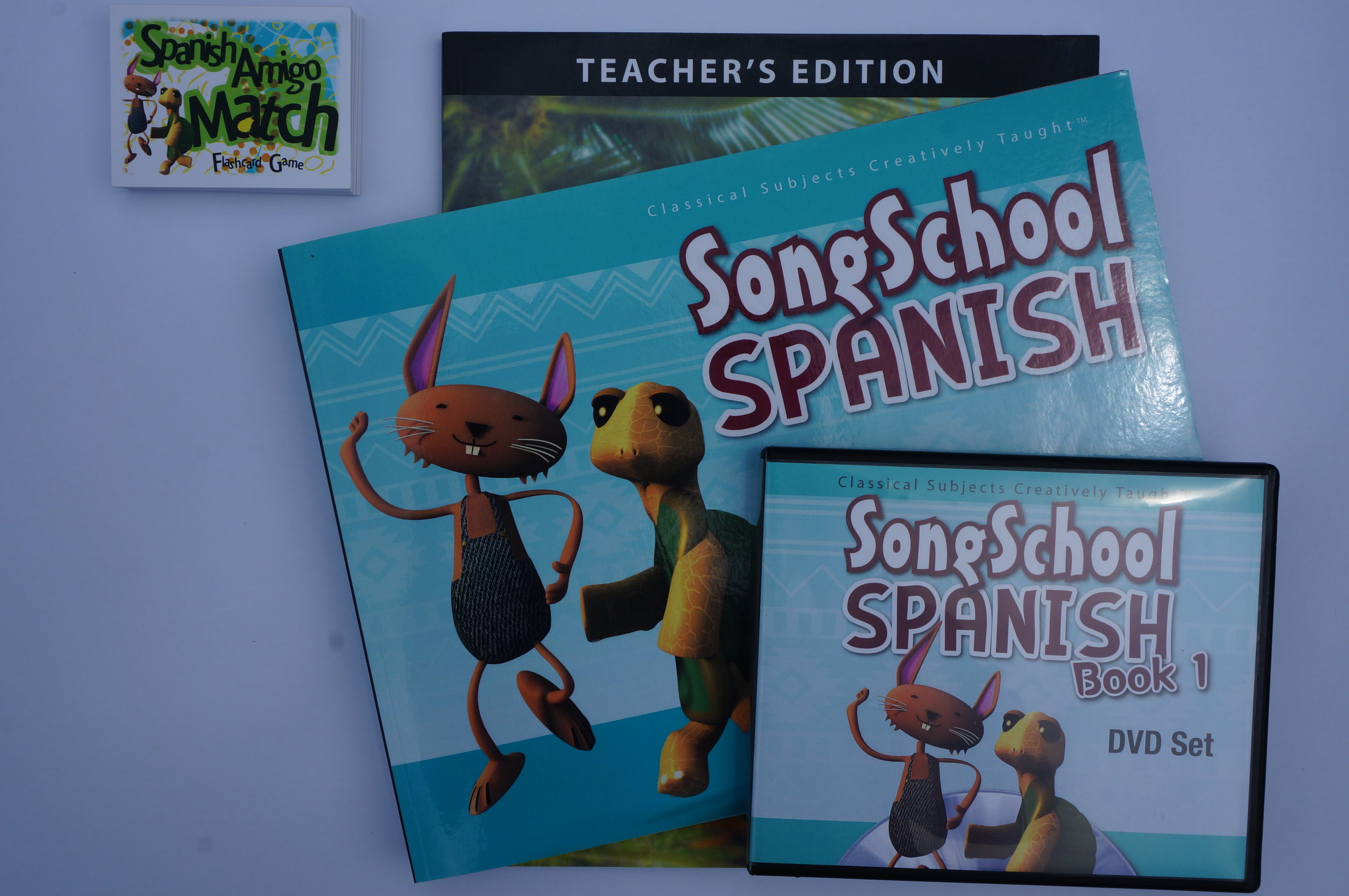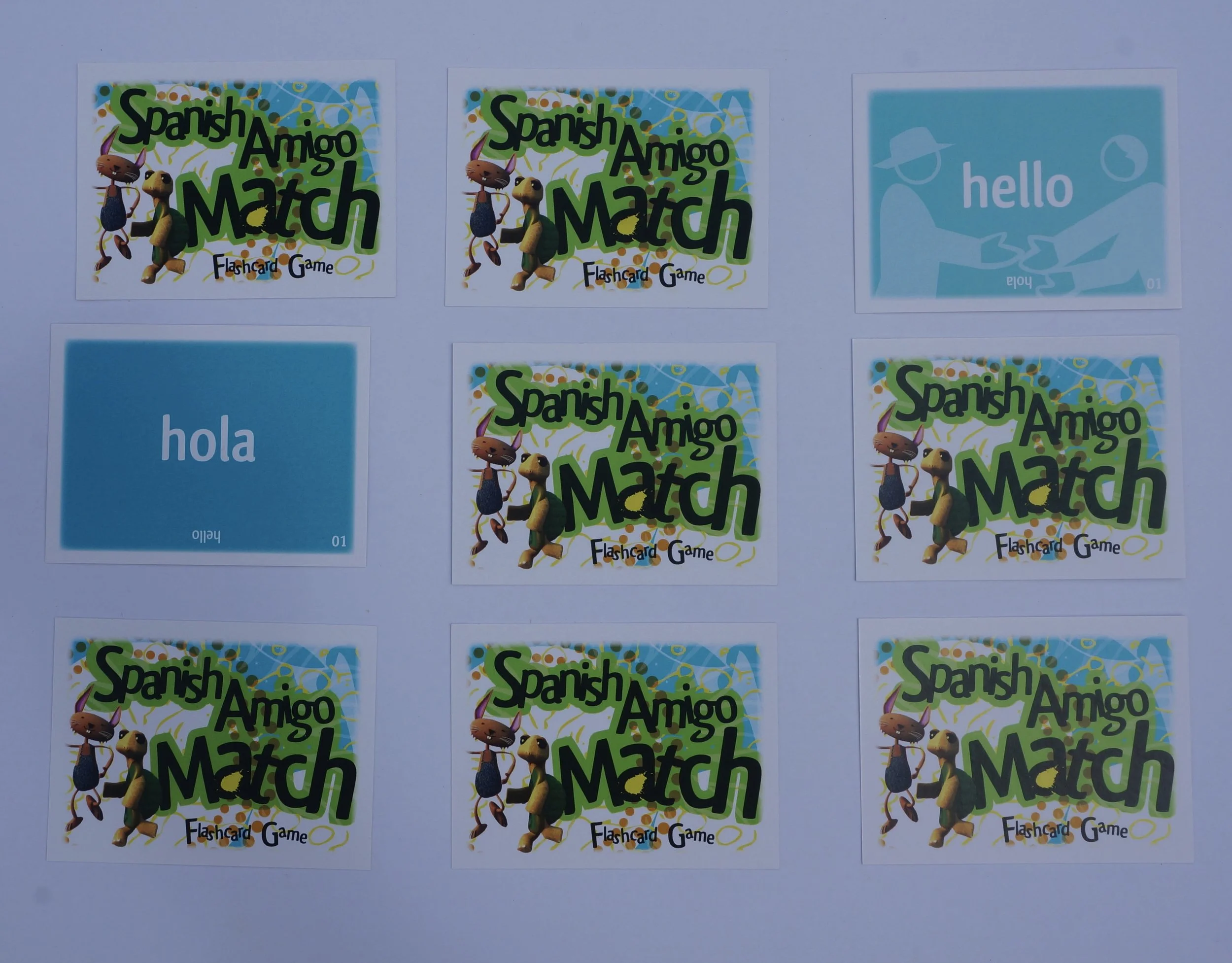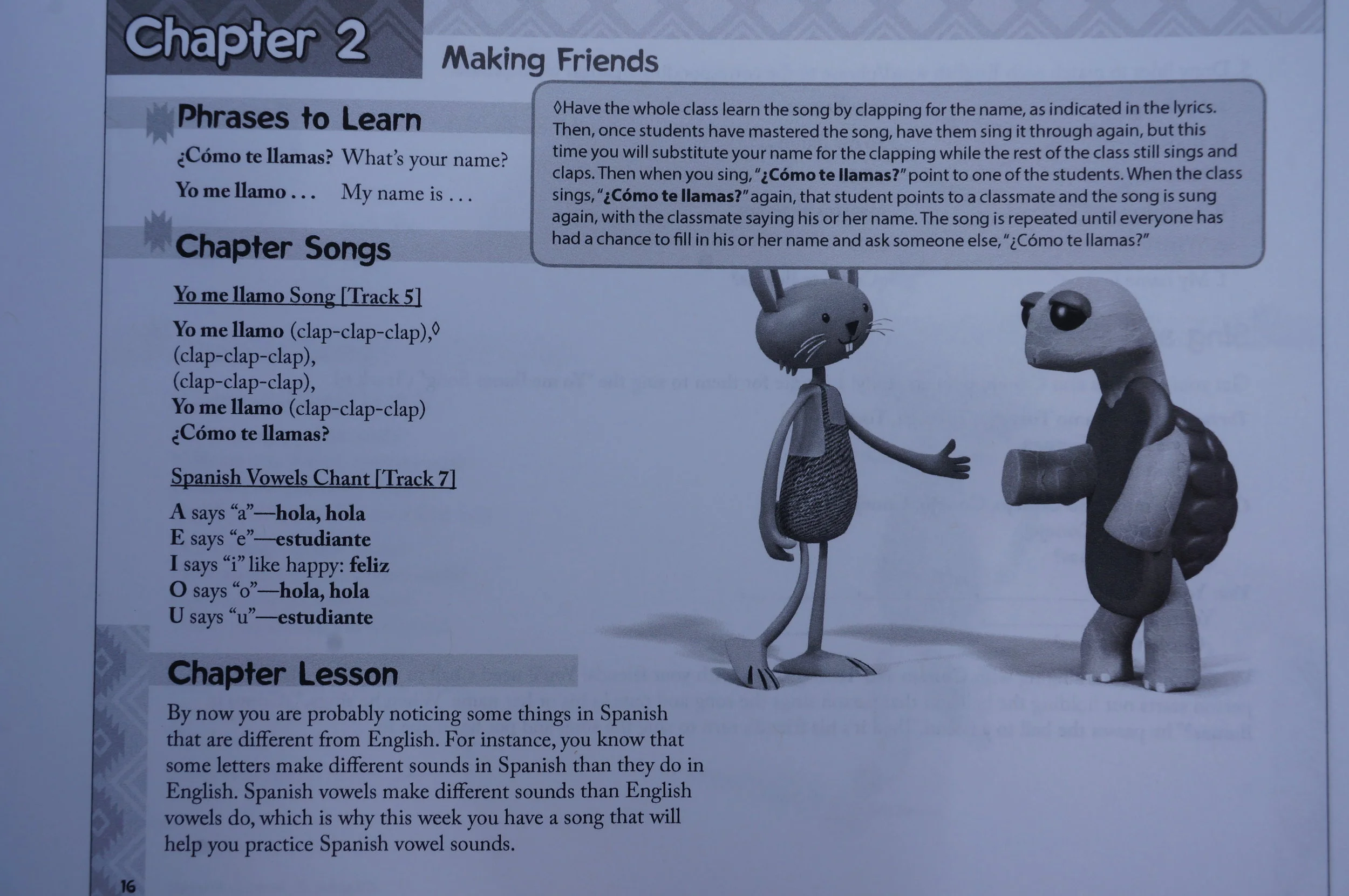Homeschool Curriculum Review: Song School Spanish
/*Note: I received a free copy of Song School Spanish (which I’ll be giving away next week!) in order to be able to provide this review.
Over in our Language Learning At Home Facebook group, a number of readers have asked me to provide a comprehensive review of Song School Spanish, Classical Academic Press’s curriculum for young Spanish learners. I’m happy to oblige!
Having reviewed the product thoroughly over the past few weeks, I’m now ready to offer my official opinion of it. By the way, if you’re curious to know how I review homeschool foreign language curriculum, here’s a post explaining my review process and how it helps me write informative and unbiased evaluations of these products.
Before I jump into that review, however, here are some basic facts to give you an overview of this curriculum:
Curriculum Title: Song School Spanish
Target Ages: Grade K—Grade 2
Cost: $82-87/one yearlong course
Materials Included: Student workbook, instructor’s guide, instructional DVD (or streaming video), vocabulary flashcards
Summary: Song School Spanish is a well-constructed, developmentally appropriate, and non-intimidating curriculum for young Spanish learners. It can be used in a co-op setting or by parents who are able to invest 1.5-2 hours a week in the subject. Notably, teachers do not need to be able to speak Spanish in order to be able to use this curriculum. It is highly engaging for children and effectively teaches very basic vocabulary, though families who are pursuing fluency will want to continue with Song School Spanish 2 (now available) and possibly supplement with outside resources (my ideas for that here).
And now, here’s the longer version, where I evaluate the curriculum from the perspective of a language teacher and homeschooling mom. You’ll note that these questions reflect the rubric that I outlined in my earlier post—I included them so that you can see the various elements that I consider as I review each foreign language curriculum that I receive.
My evaluation of Song School Spanish (as a language teacher):
Does Song School Spanish curriculum use best practices in language teaching? Yes.
Song School Spanish combines a number of different approaches to help children learn their new language—and that combination is precisely what makes this curriculum an effective teaching tool.It adapts elements of the audio-lingual approach for use with young children, making songs and chants the foundation of the curriculum. Children learn new words and phrases through the highly repetitive (yet still enjoyable) bilingual audio on this CD. Each of those words and phrases is repeated and used in context in the videos that are provided as a part of the curriculum Song School Spanish also makes use of communicative activities, which get children using the language in real situations from their very first lesson. This is something that I really like about the program—and especially so because the writers of the curriculum have thoughtfully designed these communicative activities so that they can be accurately led by a non-proficient teacher, such as a mom studying Spanish alongside her kids). In addition, many of these communicative activities are multi-sensory, which both reflect young kids’ need for movement and increases the chances that they will retain the new vocabulary they’re learning, since they are connecting new words to music and movement. Finally, light writing practice cements new vocabulary and basic grammar concepts in the minds of young learners. All together, this curriculum offers a comprehensive and balanced approach to learning Spanish.
Is it developmentally appropriate for the ages that it is marketed to? Yes.
One of the most obvious strengths of Song School Spanish is that it is FUN—which is particularly important with this age group. Since you can’t expect a first grader to be particularly self-motivated to learn a new language, any materials that you use must be able to get (and keep) their attention. The songs and games included in the curriculum ensure that this is the case for Song School Spanish students.
Moreover, vocabulary acquisition, versus the memorization of grammar rules, is the emphasis of this curriculum. This is completely appropriate for young children—even those that we consider to be in the “grammar” stage of their development. Because they must first be comfortable with a language before they can learn any of its rules, vocabulary should be the main emphasis for a student of this age.
However, I do have one thing to note with regards to the developmental appropriateness of this curriculum. Song School Spanish presupposes reading and writing ability, so if you’re using it with a kindergartener, you’ll have to be prepared to do a good deal of dictation and skip some of the writing activities, unless your kindergartener is particularly advanced in that regard. That said, I still think that there is value in the curriculum for 4- and 5-year-olds. My 4-year-old has learned an impressive amount of Latin from Song School Latin—which is built upon the same principles—and I love that he’s excited about “practicing his Latin,” which, in and of itself, is an important goal for this age group.
Does it have realistic expectations for student learning throughout its course of study? Yes.
Song School Spanish has realistic expectations of both students and parents in terms of amount of material covered and how much daily/weekly practice is needed.
Is it logically sequenced? Yes.
Here is a picture of the table of contents to give you a sense of how Song School Spanish progresses through its 31 lessons. The chapters build off each other in a natural way, so that more and more Spanish can be used in practice activities as children continue throughout the curriculum—and students loop back around to earlier concepts as they progress through the book.
The 31 chapters also include 5 review chapters, which are very important. I’ve written before about the value of paced review for foreign language learners and am glad to see this included in the curriculum.
One tiny quibble: greetings are only introduced in the final lesson, after teaching the times of day. If I were to re-write the curriculum, I’d put both of those lessons earlier, since greetings are so important in Latin culture—when greeting someone on the street, for example, you almost always say “Buenos días” or “Buenas tardes.” Just something that caught my eye, as I've never seen another Spanish curriculum that left greetings for last. Usually, they are taught alongside introductions.
Does it introduce new material clearly and provide adequate practice opportunities? Yes.
New material is presented to children in a number of ways, which is ideal from a comprehension perspective. Not only do kids hear new vocabulary in the songs and chants included in the curriculum, but they get plenty of practice with communicative activities, very light copywork (appropriate for this age group), flashcard matching activities, and other vocabulary-reinforcing work.
Note that instruction is provided principally in English, as this curriculum does not require parents to have any proficiency in Spanish.
Are the assessments included in the curriculum aligned with its teaching? Yes.
No formal assessments are included in this curriculum, but the practice activities are aligned with the concepts that are taught in each unit.
Is it engaging, from a student perspective? Yes.
Answered above.
Does it include cultural learning to help students put language in a broader context? Not really.
The songs included in the Song School Spanish CD do have a distinctly Latin style to them, but aside from one use of the word “Cielo” (a Spanish term of endearment), the lyrics are light on cultural learning. The lessons in the student workbook also eschew explicit cultural lessons, except for two brief and very general references to the cultural and geographic diversity of the Spanish-speaking world. I personally would have liked to see a bit more cultural learning included in this curriculum—using a Latin American folktale in one of the practice activities, for example, instead of interjecting Spanish into the story of Goldilocks—but this isn’t a deal-breaker for me. If you do decide to use this curriculum and want your child to get a better sense of the countries where Spanish is spoken, don’t forget to read this post and check my Homeschool Spanish Learning Pinterest board, where I collect geography and cultural learning activities for families just like you!
My evaluation of Song School Spanish (as a homeschooling mom):
What level of language proficiency does it require of the teacher (i.e. homeschool mom)? None.
None—but if mom chooses to listen to the accompanying CD and watch the video lessons along with her children, she will quickly pick up the same vocabulary and grammar that her kids are learning. This is something that I highly recommend parents of young children do, if at all possible, since the human element of language learning is so important at this age (and kids benefit from the accountability of having someone else go through the curriculum alongside them).
What level of preparation and teaching does it require from mom? Very little.
This is an open-and-go type of book. Mom really doesn’t have to do anything aside from having the materials at the ready. And while younger children may need mom’s help with some of the actitvies—as I mentioned above—second or third graders could likely handle this themselves, and even work through the activities together.
If it does require mom's involvement, are the lesson plans and schedule presented clearly? Yes.
I didn’t find a single activity in this book that left me unclear about exactly what I (and my child) needed to do—and the teacher’s manual contained a number of helpful additional tips for parents unfamiliar with the Spanish language. Here’s a sample so that you can see:
Furthermore, an easy three-unit schedule is provided, so that parents know what to tackle on each of the three days that they should devote to studying a new chapter in the book.
How much instruction is provided via screens? Some—but the focus is on real-life practice.
Video instruction is provided in this curriculum (either as a DVD or streaming video) and the lessons are clear, approachable, and appropriately short for this age range. If you choose to use them, I would recommend watching them alongside your children, so that you can encourage their participation and check for understanding.
Can it be used for multiple children (either at the same time, or reused later on)?
This could definitely be used for multiple children, though you’ll have to purchase additional workbooks in order for them to have their own. Older children will likely move through this curriculum faster (as is the case with any multi-age curriculum), but if they do, I would just send them over to Headventureland.com, where Classical Academic Press has provided additional practice activities and games for language learners. That could keep them occupied while you help younger children through the material.
Does it align with any particular homeschool philosophy? Not perfectly—and that’s okay.
Although Song School Spanish is published by Classical Academic Press, it can be used by families who ascribe to nearly any homeschooling philosophy. Yes, it has elements of the Grammar-Translation approach (the most “Classical” method of teaching languages), but they are appropriately light, so as to keep the curriculum suitable for young children. In addition, the audio-lingual and communicative activities in Song School Spanish even mirror some of the principles of Charlotte Mason’s direct method of language instruction. The curriculum isn’t “purely” Charlotte Mason, of course, but it’s close enough that CM families should feel comfortable using it (and take heart in the fact that this is an extremely well written and effective language curriculum).
Does the cost reflect the value offered in the curriculum? Yes.
All in all, Song School Spanish is a carefully constructed, well-rounded Spanish curriculum that offers the clear structure and support that non-proficient parents need in order to introduce the language to their young children. It’s worth the (relatively minor) investment.









